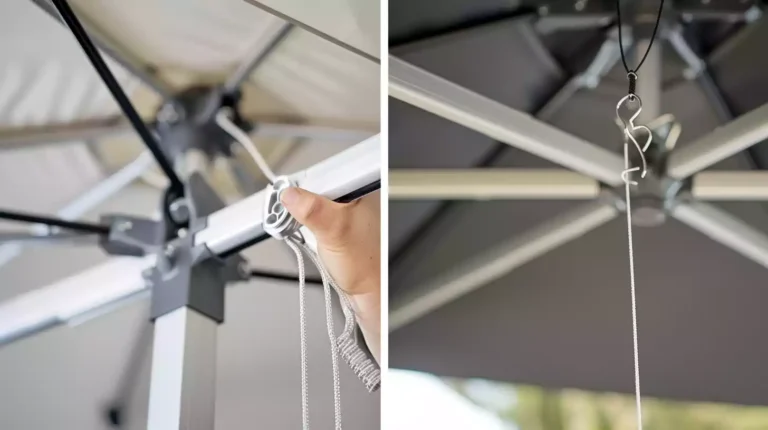How to Stop a Cantilever Umbrella from Swaying?
Balancing the tranquility of a shaded oasis with the frustration of a swaying cantilever umbrella can be a challenge. But fear not, as there are practical solutions to this predicament.
By addressing the stability of the base through strategic methods and adjustments, you can enjoy a peaceful outdoor retreat without the nuisance of a restless umbrella.
Let’s look at the key strategies and techniques that can help you achieve a steady and secure setup for your cantilever umbrella.
Continue Reading to Understand These Key Points:
- Opt for umbrellas with anti-sway brackets for added stability.
- Ensure proper canopy tension adjustment in windy conditions.
- Use heavy base weights and wind-resistant fabrics for steadiness.
- Explore anchoring options like sandbags or bolting for sway prevention.
Understanding Cantilever Umbrella Mechanics
Studying the mechanics of cantilever umbrellas reveals how their offset support system allows for versatile adjustments in height, direction, and tilt.
Cantilever umbrellas have a unique design where the canopy is held away from the central support by an extending arm attached to the pole. This design feature offers a greater range of shading options and flexibility in positioning the umbrella to effectively block the sun.
The offset design of the cantilever umbrella not only gives it a modern and stylish look but also enhances functionality by providing adjustable shading angles without a central pole’s interference.
The components of a cantilever umbrella, including the base, pole, arm, and canopy, work together to create a unique shading solution for outdoor spaces.
Proper size and weight distribution are essential considerations to ensure the umbrella remains balanced and stable, especially when adjusting the height or tilt to adapt to changing sunlight angles.
Selecting the Right Umbrella Base
When choosing the right umbrella base for a cantilever umbrella, consider factors like weight, material durability, design compatibility, and mobility features.
Opt for a base weighing between 50-80 pounds, made of concrete, stone, or steel for stability and robustness.
Select a base shape that complements the umbrella design and look for bases with wheels for easy movement.
Proper base selection is crucial to stabilize the umbrella, reducing swaying and enhancing functionality and longevity of your outdoor setup.
Proper Umbrella Installation Steps
To ensure stability and proper functioning of your cantilever umbrella, meticulously follow these precise installation steps.
Position the umbrella in an open area free from obstacles.
Place the base on a flat and stable surface to prevent any swaying that could compromise stability.
Stabilize the umbrella further by adding weights such as sandbags or concrete blocks to the base.
During installation, check and tighten all bolts, nuts, and screws to ensure everything is secure.
Proper installation is crucial in preventing swaying and maintaining stability over time.
Utilizing Wind-Resistant Features
After installing your cantilever umbrella correctly, it’s crucial to utilize wind-resistant features to enhance stability and durability. Wind can challenge the umbrella’s stability, but with the right features, you can ensure it remains secure even in windy conditions.
Consider these key wind-resistant features:
- Ventilation Systems: Opt for umbrellas with ventilation systems that allow wind to pass through, reducing swaying or toppling in strong gusts.
- Anti-Sway Brackets: These brackets minimize swaying by providing extra support and anchoring the umbrella securely.
- Canopy Tension Adjustments: Adjustable tension settings help tighten the canopy during windy weather, improving its wind resistance.
- High-Quality Wind-Resistant Fabrics: Choose umbrellas made from durable fabrics designed to withstand harsh conditions without quick deterioration.
Adding Extra Weight to the Base
To enhance the stability of a cantilever umbrella, adding extra weight to the base is crucial. Proper weight distribution across the base, securing anchors in place, and understanding the impact of wind are key considerations.
Base Weight Distribution
When considering base weight distribution for a cantilever umbrella, it’s crucial to add extra weight for stability and prevent swaying.
- Use Heavy Materials: Choose durable materials like concrete blocks, stone, or steel for the base to maintain stability.
- Match Base to Umbrella Design: Ensure the base shape complements the umbrella design for better balance and reduced swaying.
- Add Recommended Weight: Aim to add 50-80 pounds of weight to the base for average-sized cantilever umbrellas to enhance stability.
- Consider Mobility Options: Opt for a base with wheels to facilitate movement without compromising stability.
Proper base weight distribution is key to minimizing swaying and ensuring overall stability of your cantilever umbrella.
Secure Anchor Placement
Properly securing the anchor placement for a cantilever umbrella involves adding extra weight to the base for stability. To anchor the umbrella effectively, use sand or water in the base to increase its weight and prevent swaying.
Ensure the weight is evenly distributed to minimize movements in windy conditions. By anchoring the base securely, the umbrella is less likely to tip or spin, providing a sturdy foundation.
Drive the anchors deep into the ground for optimal performance and to withstand external forces, improving overall stability.
Impact of Wind
Increasing the base weight significantly enhances cantilever umbrellas’ stability in windy conditions. When addressing wind impact, consider the following:
- Base Weight Range: Choose a base weight between 50-80 pounds, depending on the umbrella size, to strengthen stability.
- Proper Weight Distribution: Ensure even weight distribution in the base to maintain balance and reduce swaying.
- Heavy-Duty Materials: Opt for bases made from strong materials like concrete or steel for better wind resistance.
- Counteracting Wind Forces: The extra weight helps counteract wind forces, keeping the umbrella steady and secure in challenging conditions.
Installing a Cone Wedge
To enhance the stability of a cantilever umbrella, consider installing a cone wedge between the base and the pole. A cone wedge is a stabilizing device designed to secure the umbrella and prevent swaying.
By inserting the cone wedge at the base of the umbrella, additional support is provided, reducing movement and enhancing overall stability, especially in windy conditions.
Cone Wedge Installation Guide:
| Step | Instructions |
|---|---|
| 1 | Loosen the bolts on the base of the umbrella. |
| 2 | Insert the cone wedge between the base and the pole. |
| 3 | Tighten the bolts securely to hold the cone wedge in place. |
| 4 | Test the stability of the umbrella by gently shaking it. |
Installing a cone wedge is a practical solution to minimize swaying and ensure your cantilever umbrella remains steady and secure.
Using Bungee Cords for Security
Bungee cords provide enhanced security by tethering the canopy of a cantilever umbrella to prevent swaying in windy conditions. When used correctly, bungee cords can greatly stabilize a cantilever umbrella, offering peace of mind on breezy days.
Key points to consider when using bungee cords for security include:
- Attachment Points: Secure one end of the bungee cord to the canopy and the other end to a stable part of the frame or support structure.
- Tension Adjustment: Adjust the tension of the bungee cord to hold the canopy firmly without straining the umbrella’s components.
- Even Distribution: Distribute multiple bungee cords evenly around the canopy for balanced stabilization.
- Regular Inspection: Periodically check the bungee cords for wear and tear, replacing any damaged cords promptly for optimal security.
Using bungee cords is a practical and efficient way to enhance the stability of your cantilever umbrella, minimizing swaying and reducing the risk of tipping over in gusty winds.
Will a New Canopy Replacement Help Stop the Swaying of a Cantilever Umbrella?
Yes, a new canopy replacement can help stop the swaying of a cantilever umbrella. To remedy this issue, simply follow the instructions on how to replace the canopy. The new canopy will provide better stability and support, reducing the swaying motion of the umbrella.
Can Restringing a Cantilever Umbrella Help Prevent Swaying Issues?
Yes, restringing a cantilever umbrella can help prevent swaying issues. Over time, the strings may become worn or loose, causing instability. By restringing the umbrella with strong, durable cords, you can ensure that the canopy remains securely in place, reducing the risk of swaying in windy conditions.
Vented Umbrella Benefits
Incorporating vented umbrellas into your outdoor setup can significantly enhance stability by allowing wind to pass through the canopy, reducing strain and minimizing swaying. Vented umbrellas are specifically designed with openings or mesh panels to improve air circulation and promote stability.
The ventilation systems in vented umbrellas play a crucial role in enhancing wind resistance, preventing canopy inversion, and maintaining the umbrella’s shape and structure during windy conditions.
By choosing a vented umbrella, you can effectively reduce swaying movements caused by wind pressure, ensuring a more secure and reliable outdoor shading solution.
The strategic placement of vents in these umbrellas facilitates the airflow, decreasing the chances of the umbrella being lifted or overturned by strong winds.
Overall, the benefits of vented umbrellas in terms of wind resistance and stability make them a practical choice for enhancing your outdoor experience.
Smart Wind-Blocking Strategies
When considering smart wind-blocking strategies for cantilever umbrellas, one should explore windbreak options and anchoring techniques to enhance stability.
Wind-resistant features like vented canopies and high-quality fabrics can aid in minimizing swaying movements.
Reinforced frames and proper installation with heavy bases play crucial roles in optimizing wind tolerance for cantilever umbrellas.
Windbreak Options
To enhance stability and minimize swaying of a cantilever umbrella, consider utilizing windbreak options like outdoor screens, fences, or hedges to create a protective barrier against strong winds.
Smart wind-blocking strategies include:
- large potted plants placed strategically
- a retractable windbreak system for adjustable protection
- permanent windbreak structures like pergolas or privacy walls
- temporary solutions such as fabric panels or sail shades.
These options effectively safeguard your umbrella and enhance your outdoor experience.
Anchoring Techniques
For enhanced stability and wind resistance of a cantilever umbrella, anchoring techniques play a crucial role in preventing swaying and ensuring optimal performance.
When securing a cantilever patio umbrella, consider using bungee cords to provide additional stability in windy conditions.
Utilizing concrete blocks or sandbags can also anchor the umbrella effectively, preventing it from swaying uncontrollably.
Bolting the umbrella to a deck or solid surface is another reliable method to secure it and minimize movement.
It’s essential to choose the anchoring method carefully, taking into account factors such as property ownership and mobility impact.
Are There Any Cantilever Umbrellas That Are Sturdy and Do Not Sway?
Yes, you can find the perfect cantilever umbrella that is sturdy and does not sway. Look for umbrellas with sturdy construction, durable materials, and a stable base. Consider brands known for their quality and read reviews to ensure you’re getting a reliable product.
Final Thoughts
By following the proper steps to stabilize your cantilever umbrella, you can enjoy a peaceful and relaxing outdoor experience without worrying about it swaying in the wind.
Don’t risk your umbrella getting damaged or causing a safety hazard when you can easily prevent it with a few simple adjustments.
Take control of your outdoor space and enjoy the benefits of a secure and stable cantilever umbrella today.






